Air Quality Around the World
Tens of millions of U.S. citizens spend significant time abroad each year. In the past, U.S. citizens did not have ready access to air quality data in many locations overseas. Today, thanks to a partnership between the U.S. Department of State and the U.S. Environmental Protection Agency (EPA), AirNow reaches beyond our borders to provide air quality data for Americans living and traveling abroad as well as for the broader public. This service began with the installation and operation of state-of–the-art air quality monitors at U.S. embassies and consulates. Currently, 48 U.S. embassies and consulates around the world have monitors that provide hourly data through the AirNow platform to anyone who wants it.
To further engage the public with data from air monitors as well as increase the accessibility of air quality information, the Department of State is currently developing an app that will show data from the U.S. embassy air monitors alongside EPA health messaging. The app is expected to be released by the summer of 2020 and will be available to all smartphone users for free.
By bringing in high quality equipment, and by following data collection and reporting criteria used in the United States, U.S. embassies and consulates provide Americans overseas and the broader public with reliable air quality information and health messaging that is based on the Air Quality Index (AQI) used in the United States. This rigorous monitoring and reporting of air quality information from the embassies and consulates also serves as an objective model for foreign audiences, sometimes spurring local action to address air quality issues.
Take a look at air quality data from our monitors around the world at AirNow!
Creating Innovative Solutions for Air Monitoring through Global Technology Challenge
Scientists and staff from the EPA, the National Aeronautics and Space Administration (NASA), and the Department of State crafted a “Surface-to-Air (Quality) Mission” challenge as part of the 2019 NASA International Space Apps Challenge hackathon. During a weekend in October, more than 29,000 participants in over 3,000 teams at 225 locations in 71 countries worked on one of the two dozen challenges, with 91 teams taking on the air quality challenge. Teams participating in this challenge proposed innovative solutions to integrating NASA satellite data, ground monitor data, model data, and citizen science data to create a visualization of air quality that displayed the best data for a given location and time. Teams produced a 30-second video for the judging panel, with some teams even producing prototype code and websites. Fourteen of the 91 teams participating in the air quality challenge were nominated for global awards, and one team from Sydney, Australia, was selected as a finalist. Winners of the global awards worked on other challenges that included creating automated systems to improve the public health response to the dengue virus and detecting ocean oil spills using satellite imagery. For more details on the air quality challenge, visit the challenge site.

Global Award Nominee – CAFE: Clean Air For Everyone; Kuala Lumpur (Image: NASA)
Wildfires and Smoke around the World: Case Study
Many U.S. embassies and consulates are in locations that are sometimes affected by wildfires and other extreme air pollution events. Having a response plan in place promotes timely, transparent, and effective actions to reduce anxiety and health risks to staff and family members.
During the Australia bush fires of 2019-2020, the U.S. Embassy in Canberra and multiple State Department offices worked together to communicate and reduce air pollution exposures and health risks to personnel.
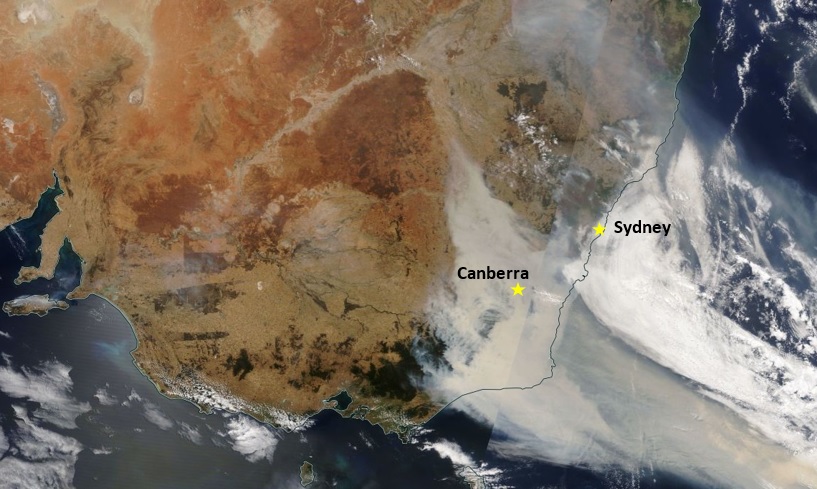
Image: NASA Worldview, January 1, 2020, with major cities labeled
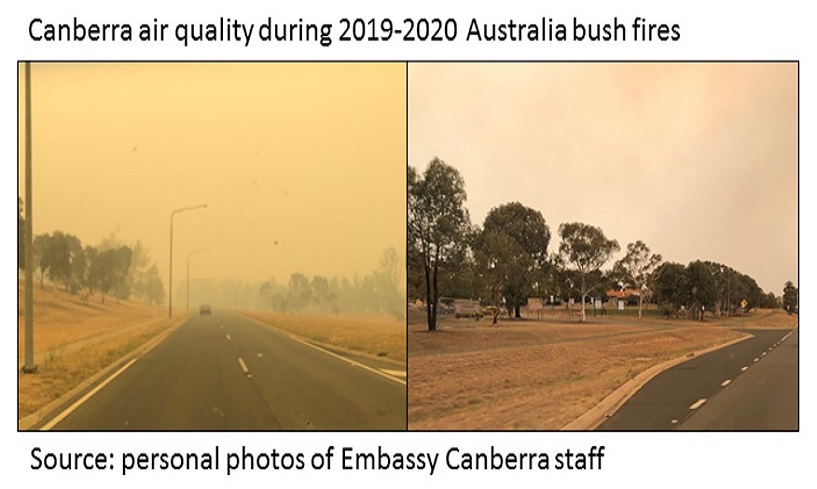
Understanding air quality and fire trends
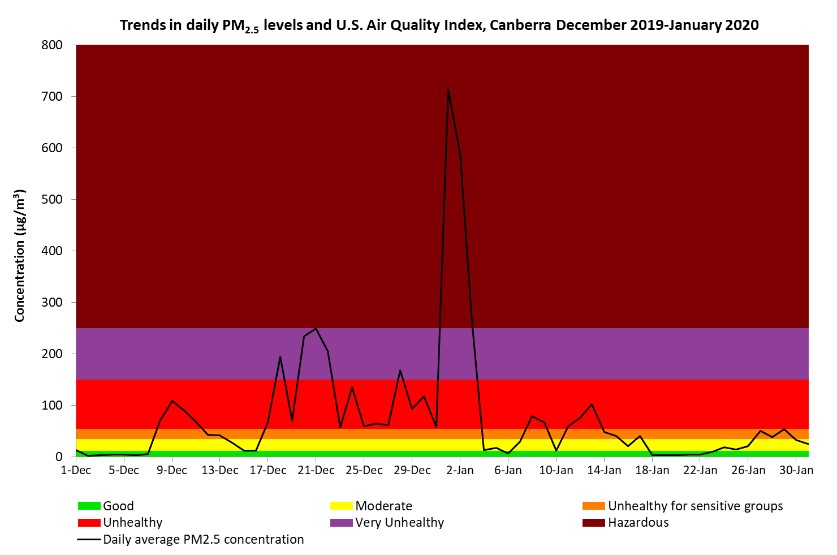 From mid-December to mid-January in Canberra, Australia, levels of fine particulate matter (PM2.5, particles 2.5 micrometers or smaller) were mostly “Unhealthy” on the U.S. Air Quality Index (AQI) scale and “Hazardous” for three consecutive days.
From mid-December to mid-January in Canberra, Australia, levels of fine particulate matter (PM2.5, particles 2.5 micrometers or smaller) were mostly “Unhealthy” on the U.S. Air Quality Index (AQI) scale and “Hazardous” for three consecutive days.
To understand whether conditions would change, local fire service, embassy staff, and experts at State Department headquarters exchanged information on air quality, fire, and weather forecasts.
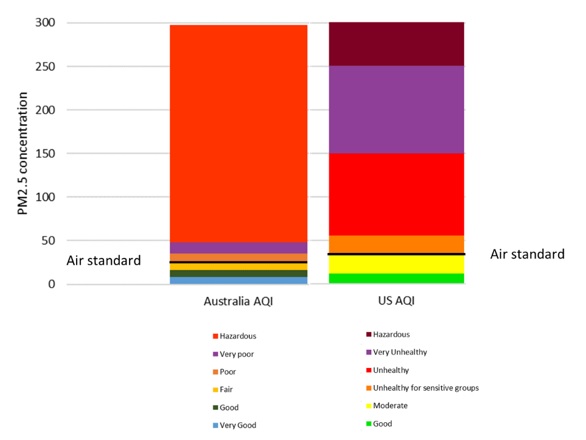 State Department experts communicated this information to embassy staff and family members, along with advice about where to find reliable air quality information, how to interpret the Australian AQI, and what actions to take. A key goal was to reduce alarm over local AQI reports of 1000-3000 by translating to the more familiar U.S. AQI.
State Department experts communicated this information to embassy staff and family members, along with advice about where to find reliable air quality information, how to interpret the Australian AQI, and what actions to take. A key goal was to reduce alarm over local AQI reports of 1000-3000 by translating to the more familiar U.S. AQI.
Understanding health risks and managing health conditions
State Department experts shared factsheets and webpages to describe the health effects linked to higher air pollution exposure. The science of exposure duration and whether exposure to short-term, high air pollution levels can lead to long-lasting effects was explained.
Embassy medical staff encouraged personnel to seek medical care if symptoms became difficult to control or worsened over time. Asthma management plans were implemented to help people with asthma know what to do to avoid or control an asthma attack.
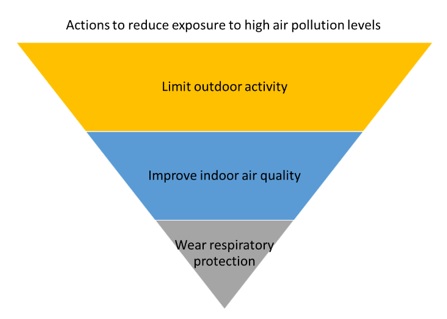 Making decisions on outdoor activity
Making decisions on outdoor activity
Embassy medical staff advised personnel to follow the U.S. AQI guidance for outdoor activity. Those who wished to use masks were advised to use them as a last resort if being outdoors for several hours was necessary. People were recommended to look for N95 respirators, select a tight-fitting size, and check for a seal to the face.
Reducing indoor air pollution
The Embassy provided portable indoor air filters for staff homes. They also instructed citizens on how to reduce leaks around windows and doors and how to balance enhanced air filtration with cooling during extreme heat conditions. Indoor air quality was monitored with low-cost sensors.
Lessons learned
The Australian bush fires of 2019-2020 highlighted the importance of having a concrete emergency response plan in place for timely action as well as the importance of regularly communicating to citizens best available information on air quality conditions and health risks. By understanding the empirical foundations of pollution and health effects, we can be better positioned to take proper action to reduce risk for ourselves and our communities.












